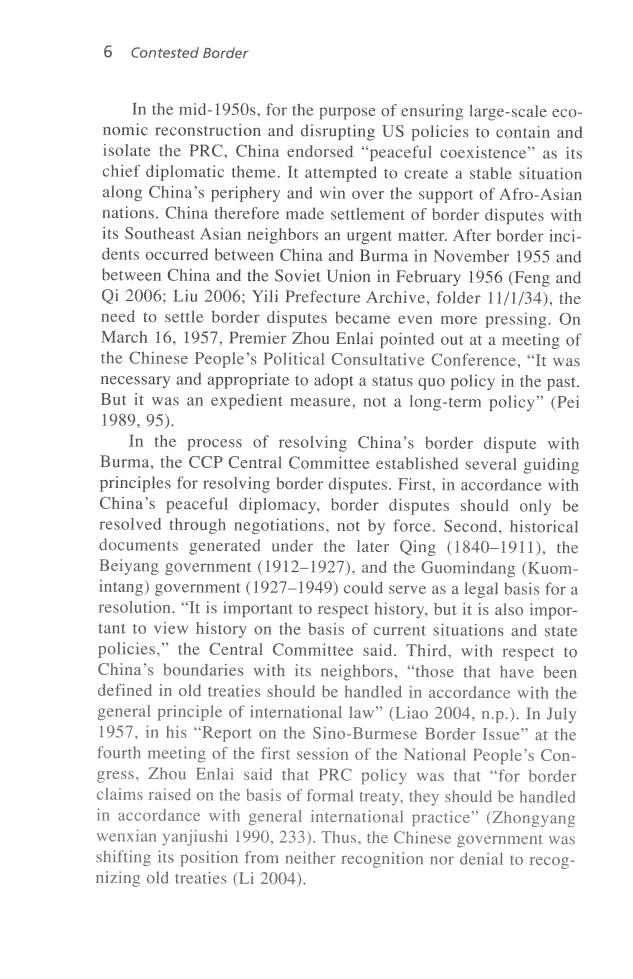
6 Contested Border In the mid-1950s,for the purpose of ensuring large-scale eco- nomic reconstruction and disrupting US policies to contain and isolate the PRC,China endorsed "peaceful coexistence"as its chief diplomatic theme.It attempted to create a stable situation along China's periphery and win over the support of Afro-Asian nations.China therefore made settlement of border disputes with its Southeast Asian neighbors an urgent matter.After border inci- dents occurred between China and Burma in November 1955 and between China and the Soviet Union in February 1956(Feng and Qi 2006:Liu 2006;Yili Prefecture Archive,folder 11/1/34),the need to settle border disputes became even more pressing.On March 16,1957,Premier Zhou Enlai pointed out at a meeting of the Chinese People's Political Consultative Conference,"It was necessary and appropriate to adopt a status quo policy in the past. But it was an expedient measure,not a long-term policy"(Pei 1989,95). In the process of resolving China's border dispute with Burma,the CCP Central Committee established several guiding principles for resolving border disputes.First,in accordance with China's peaceful diplomacy,border disputes should only be resolved through negotiations,not by force.Second,historical documents generated under the later Qing (1840-1911),the Beiyang government(1912-1927),and the Guomindang (Kuom- intang)government (1927-1949)could serve as a legal basis for a resolution."It is important to respect history,but it is also impor- tant to view history on the basis of current situations and state policies,"the Central Committee said.Third,with respect to China's boundaries with its neighbors,"those that have been defined in old treaties should be handled in accordance with the general principle of international law"(Liao 2004,n.p.).In July 1957,in his"Report on the Sino-Burmese Border Issue"at the fourth meeting of the first session of the National People's Con- gress,Zhou Enlai said that PRC policy was that "for border claims raised on the basis of formal treaty,they should be handled in accordance with general international practice"(Zhongyang wenxian yanjiushi 1990,233).Thus,the Chinese government was shifting its position from neither recognition nor denial to recog- nizing old treaties(Li 2004)
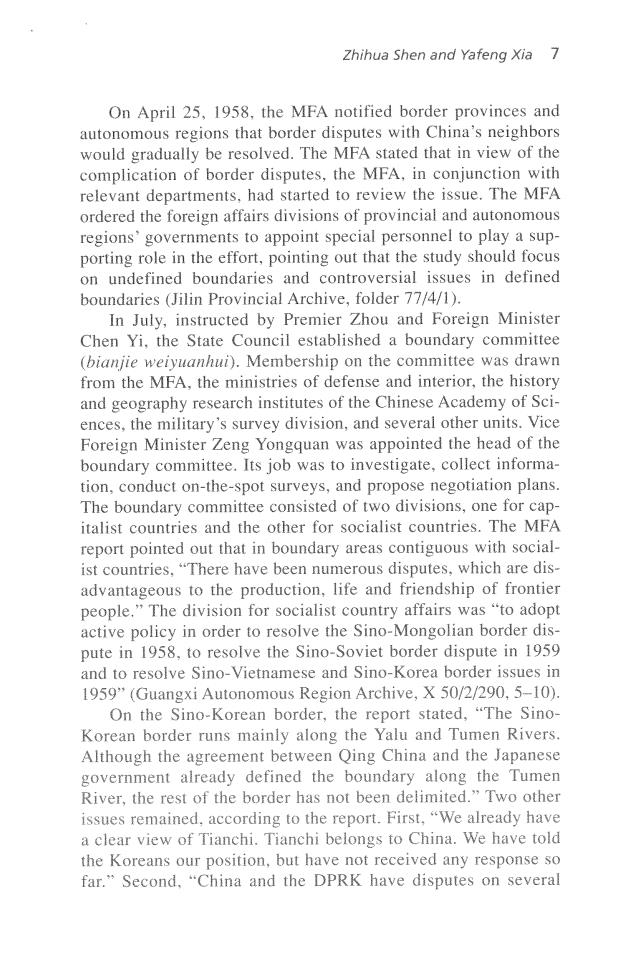
Zhihua Shen and Yafeng Xia 7 On April 25,1958,the MFA notified border provinces and autonomous regions that border disputes with China's neighbors would gradually be resolved.The MFA stated that in view of the complication of border disputes,the MFA,in conjunction with relevant departments,had started to review the issue.The MFA ordered the foreign affairs divisions of provincial and autonomous regions'governments to appoint special personnel to play a sup- porting role in the effort,pointing out that the study should focus on undefined boundaries and controversial issues in defined boundaries (Jilin Provincial Archive,folder 77/4/1). In July,instructed by Premier Zhou and Foreign Minister Chen Yi,the State Council established a boundary committee (bianjie weiyuanhui).Membership on the committee was drawn from the MFA,the ministries of defense and interior,the history and geography research institutes of the Chinese Academy of Sci- ences,the military's survey division,and several other units.Vice Foreign Minister Zeng Yongquan was appointed the head of the boundary committee.Its job was to investigate,collect informa- tion,conduct on-the-spot surveys,and propose negotiation plans. The boundary committee consisted of two divisions,one for cap- italist countries and the other for socialist countries.The MFA report pointed out that in boundary areas contiguous with social- ist countries,"There have been numerous disputes,which are dis- advantageous to the production,life and friendship of frontier people."The division for socialist country affairs was "to adopt active policy in order to resolve the Sino-Mongolian border dis- pute in 1958,to resolve the Sino-Soviet border dispute in 1959 and to resolve Sino-Vietnamese and Sino-Korea border issues in 1959"(Guangxi Autonomous Region Archive,X 50/2/290,5-10). On the Sino-Korean border,the report stated,"The Sino- Korean border runs mainly along the Yalu and Tumen Rivers. Although the agreement between Qing China and the Japanese government already defined the boundary along the Tumen River,the rest of the border has not been delimited."Two other issues remained,according to the report.First,"We already have a clear view of Tianchi.Tianchi belongs to China.We have told the Koreans our position,but have not received any response so far."Second,"China and the DPRK have disputes on several
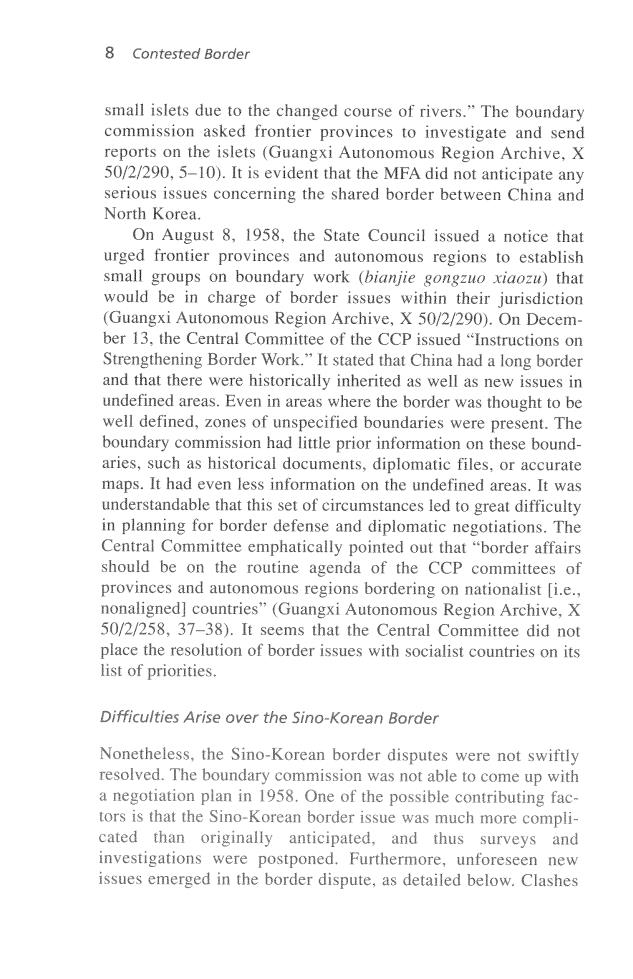
8 Contested Border small islets due to the changed course of rivers."The boundary commission asked frontier provinces to investigate and send reports on the islets(Guangxi Autonomous Region Archive,X 50/2/290,5-10).It is evident that the MFA did not anticipate any serious issues concerning the shared border between China and North Korea. On August 8,1958,the State Council issued a notice that urged frontier provinces and autonomous regions to establish small groups on boundary work (bianjie gongzuo xiaozu)that would be in charge of border issues within their jurisdiction (Guangxi Autonomous Region Archive,X 50/2/290).On Decem- ber 13,the Central Committee of the CCP issued "Instructions on Strengthening Border Work."It stated that China had a long border and that there were historically inherited as well as new issues in undefined areas.Even in areas where the border was thought to be well defined,zones of unspecified boundaries were present.The boundary commission had little prior information on these bound- aries,such as historical documents,diplomatic files,or accurate maps.It had even less information on the undefined areas.It was understandable that this set of circumstances led to great difficulty in planning for border defense and diplomatic negotiations.The Central Committee emphatically pointed out that"border affairs should be on the routine agenda of the CCP committees of provinces and autonomous regions bordering on nationalist [i.e., nonaligned]countries"(Guangxi Autonomous Region Archive,X 50/2/258,37-38).It seems that the Central Committee did not place the resolution of border issues with socialist countries on its list of priorities. Difficulties Arise over the Sino-Korean Border Nonetheless,the Sino-Korean border disputes were not swiftly resolved.The boundary commission was not able to come up with a negotiation plan in 1958.One of the possible contributing fac- tors is that the Sino-Korean border issue was much more compli- cated than originally anticipated,and thus surveys and investigations were postponed.Furthermore,unforeseen new issues emerged in the border dispute,as detailed below.Clashes
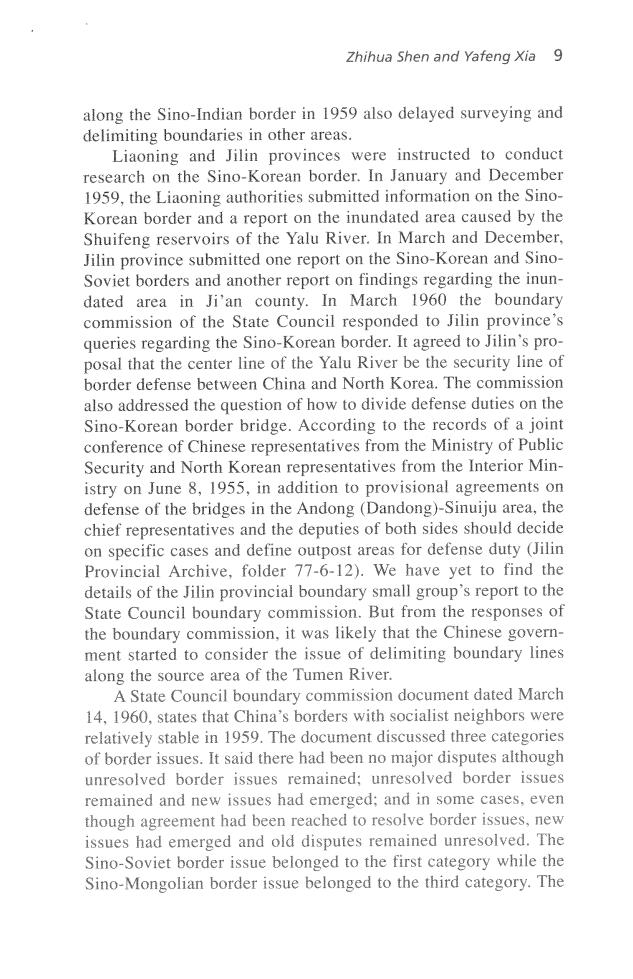
Zhihua Shen and Yafeng Xia 9 along the Sino-Indian border in 1959 also delayed surveying and delimiting boundaries in other areas. Liaoning and Jilin provinces were instructed to conduct research on the Sino-Korean border.In January and December 1959,the Liaoning authorities submitted information on the Sino- Korean border and a report on the inundated area caused by the Shuifeng reservoirs of the Yalu River.In March and December. Jilin province submitted one report on the Sino-Korean and Sino- Soviet borders and another report on findings regarding the inun- dated area in Ji'an county.In March 1960 the boundary commission of the State Council responded to Jilin province's queries regarding the Sino-Korean border.It agreed to Jilin's pro- posal that the center line of the Yalu River be the security line of border defense between China and North Korea.The commission also addressed the question of how to divide defense duties on the Sino-Korean border bridge.According to the records of a joint conference of Chinese representatives from the Ministry of Public Security and North Korean representatives from the Interior Min- istry on June 8,1955,in addition to provisional agreements on defense of the bridges in the Andong(Dandong)-Sinuiju area,the chief representatives and the deputies of both sides should decide on specific cases and define outpost areas for defense duty (Jilin Provincial Archive,folder 77-6-12).We have yet to find the details of the Jilin provincial boundary small group's report to the State Council boundary commission.But from the responses of the boundary commission,it was likely that the Chinese govern- ment started to consider the issue of delimiting boundary lines along the source area of the Tumen River. A State Council boundary commission document dated March 14,1960,states that China's borders with socialist neighbors were relatively stable in 1959.The document discussed three categories of border issues.It said there had been no major disputes although unresolved border issues remained;unresolved border issues remained and new issues had emerged;and in some cases,even though agreement had been reached to resolve border issues,new issues had emerged and old disputes remained unresolved.The Sino-Soviet border issue belonged to the first category while the Sino-Mongolian border issue belonged to the third category.The
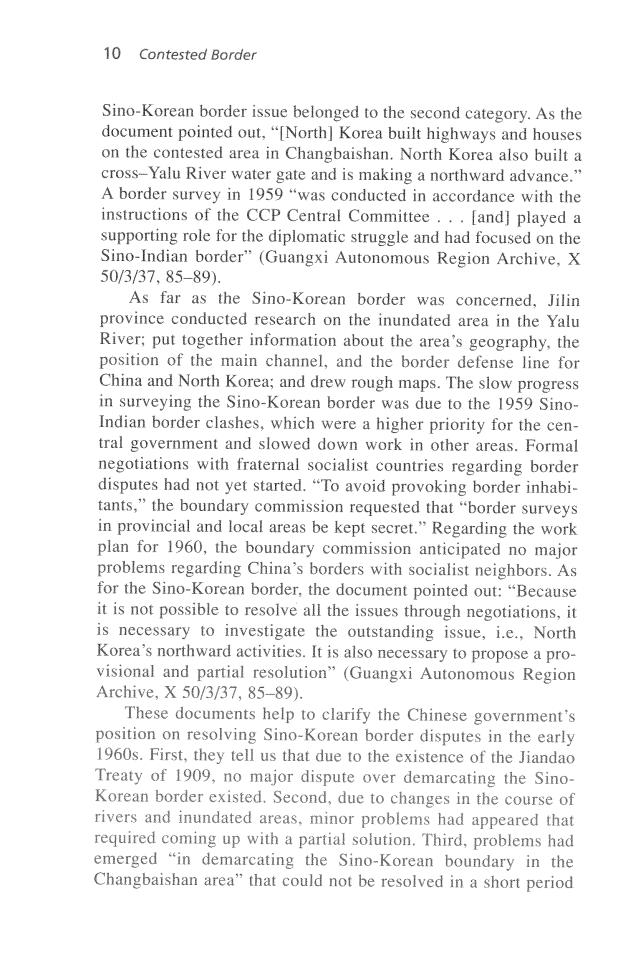
10 Contested Border Sino-Korean border issue belonged to the second category.As the document pointed out,"[North]Korea built highways and houses on the contested area in Changbaishan.North Korea also built a cross-Yalu River water gate and is making a northward advance." A border survey in 1959"was conducted in accordance with the instructions of the CCP Central Committee...[and]played a supporting role for the diplomatic struggle and had focused on the Sino-Indian border"(Guangxi Autonomous Region Archive,X 50/3/37,85-89). As far as the Sino-Korean border was concerned,Jilin province conducted research on the inundated area in the Yalu River:put together information about the area's geography,the position of the main channel,and the border defense line for China and North Korea;and drew rough maps.The slow progress in surveying the Sino-Korean border was due to the 1959 Sino- Indian border clashes,which were a higher priority for the cen- tral government and slowed down work in other areas.Formal negotiations with fraternal socialist countries regarding border disputes had not yet started."To avoid provoking border inhabi- tants,"the boundary commission requested that "border surveys in provincial and local areas be kept secret."Regarding the work plan for 1960,the boundary commission anticipated no major problems regarding China's borders with socialist neighbors.As for the Sino-Korean border,the document pointed out:"Because it is not possible to resolve all the issues through negotiations,it is necessary to investigate the outstanding issue,i.e.,North Korea's northward activities.It is also necessary to propose a pro- visional and partial resolution"(Guangxi Autonomous Region Archive,X50/3/37,85-89). These documents help to clarify the Chinese government's position on resolving Sino-Korean border disputes in the early 1960s.First,they tell us that due to the existence of the Jiandao Treaty of 1909,no major dispute over demarcating the Sino- Korean border existed.Second,due to changes in the course of rivers and inundated areas,minor problems had appeared that required coming up with a partial solution.Third,problems had emerged "in demarcating the Sino-Korean boundary in the Changbaishan area"that could not be resolved in a short period